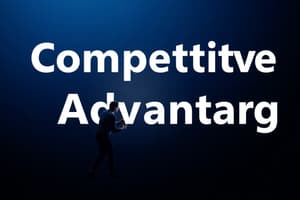Podcast
Questions and Answers
What is a potential advantage of globalization for businesses?
What is a potential advantage of globalization for businesses?
- Higher production costs
- A larger source of market opportunities (correct)
- Increased tariffs on trade
- Decreased access to international materials
What is a disadvantage of globalization that impacts businesses?
What is a disadvantage of globalization that impacts businesses?
- Increased competition in the global market (correct)
- Limited access to technology
- Simplicity in supply chain management
- Reduction in free trade agreements
Which driving force of globalization relates directly to trade practices?
Which driving force of globalization relates directly to trade practices?
- Improvement in technology
- A larger source of labor
- Increased acceptance of e-commerce
- Removal of protectionist trade barriers (correct)
How can outsourcing benefit businesses in a globalized market?
How can outsourcing benefit businesses in a globalized market?
What implication does globalization have on operational strategies for businesses?
What implication does globalization have on operational strategies for businesses?
What impact does an increasing volume of global trade have on businesses?
What impact does an increasing volume of global trade have on businesses?
What is global sourcing?
What is global sourcing?
What change might businesses need to implement due to globalization?
What change might businesses need to implement due to globalization?
What is the primary focus of legal compliance for a business?
What is the primary focus of legal compliance for a business?
Which of the following is considered a component of labour law compliance?
Which of the following is considered a component of labour law compliance?
What is the purpose of environmental and public health compliance?
What is the purpose of environmental and public health compliance?
Which of the following describes the role of intellectual property laws?
Which of the following describes the role of intellectual property laws?
What is typically included within taxation requirements for businesses?
What is typically included within taxation requirements for businesses?
What aspect do trade practices regulations primarily address?
What aspect do trade practices regulations primarily address?
What is the purpose of financial and accounting regulations?
What is the purpose of financial and accounting regulations?
Human rights regulations in a business context restrict discrimination based on which of the following?
Human rights regulations in a business context restrict discrimination based on which of the following?
What type of production is typically used for high-variety, low-volume manufacturing?
What type of production is typically used for high-variety, low-volume manufacturing?
What is a characteristic of product production?
What is a characteristic of product production?
Which layout is most commonly used in product production?
Which layout is most commonly used in product production?
In which type of production does the product remain in one location due to its weight or bulk?
In which type of production does the product remain in one location due to its weight or bulk?
What aspect does the product layout focus on?
What aspect does the product layout focus on?
Why might process production be particularly useful in hospitals?
Why might process production be particularly useful in hospitals?
How does the assembly line layout enhance production efficiency?
How does the assembly line layout enhance production efficiency?
What is a significant advantage of process production in supplier management?
What is a significant advantage of process production in supplier management?
What is one method businesses can use to achieve low operational costs?
What is one method businesses can use to achieve low operational costs?
How can a company differentiate its products from competitors?
How can a company differentiate its products from competitors?
Which of the following is NOT a way to achieve low cost through operations?
Which of the following is NOT a way to achieve low cost through operations?
What does product differentiation primarily focus on?
What does product differentiation primarily focus on?
Which factor can contribute to a competitive position regarding pricing?
Which factor can contribute to a competitive position regarding pricing?
What does scheduling mainly refer to in the context of project management?
What does scheduling mainly refer to in the context of project management?
Which of the following is an advantage of Gantt charts?
Which of the following is an advantage of Gantt charts?
What is one disadvantage of using Gantt charts for scheduling?
What is one disadvantage of using Gantt charts for scheduling?
What essential information does Critical Path Analysis (CPA) provide about project tasks?
What essential information does Critical Path Analysis (CPA) provide about project tasks?
In project management, why is it crucial for managers to plan the steps needed to complete a task?
In project management, why is it crucial for managers to plan the steps needed to complete a task?
Flashcards are hidden until you start studying
Study Notes
Competitive Position
- A business can achieve a competitive position in terms of price through:
- Using less expensive inputs
- Maximising efficiency by minimising waste and saving time
- Producing more outputs from less inputs
- Using technology
- Producing faster
- Having lower quality outputs
- Increasing the size of operations to reduce the average cost of making each item
- Differentiation aims to obtain an advantage over competitors by having outputs that are different, unique, or use leading-edge technology
- Product Differentiation: distinguishes products (goods or services) from those of competitors
Globalisation Advantages and Disadvantages
- Advantages
- Larger source of market opportunities
- Source and choice of materials and labour
- Opportunity for outsourcing (reduce production costs)
- Disadvantages
- Increased competition in the global market
- Changes in global/regional economies can negatively impact businesses
- Changes to currencies and trade agreements can negatively impact businesses
Implications of Globalisation on Operational Strategies
- Access to larger markets for cheaper or better quality overseas resources influences input decisions.
- This is driven by a need to global source, buying from overseas suppliers, and outsourcing, where a function is fully performed by an external party
- These strategies lead to cheaper overseas labour
- Integration of overseas suppliers adds complexity and requires a global web strategy for supply chain management.
- Increasing volume impacts all aspects of the transformation process.
Legal Compliance vs. Ethical Responsibility
- Legal Compliance: follows the letter of the law and prescribed standards of behaviour
- Ethical Responsibility: goes above and beyond legal requirements, considering the impact on stakeholders
Operations Management in a Globalised World
- Labour Law Compliance: Minimum wages, award wages, working hours, breaks, leave pay, employee benefits, workers compensation, and health and safety laws.
- Environmental and Public Health Compliance: Regulations on dumping, pollution (air, land, water), and waste disposal.
- Business Licencing Rules: Requirements for training and certification, and operational conditions (such as restricted working hours, zoning restrictions, and content and disclosure restrictions)
- Taxation: Levies, duties, taxes on profits, and superannuation.
- Trade Practices and Fair Market Dealings: Addresses market power, misleading conduct, price collusion, monopolies, market concentration, and product safety.
- Migration and Rules around Offshore Skilled Labour: Minimum standards are applied to labour brought from other nations
- Intellectual Property: Copyright, patents, trademarks, designs, and original ideas
- Financial and Accounting Regulations: Standardising methods and rules for financial records, reports, and company directors' responsibilities as fiduciaries.
- Human Rights: Rules restricting discrimination on various grounds such as disability, culture, sexual preference, gender, age, or any other distinguishing feature.
Scheduling Techniques
- GANTT Charts: outlines activities to be performed, their order, individual duration, and total project duration
- Advantages: simple planning, easy to understand, monitor, and compare progress against planned activities.
- Disadvantages: not suitable for complex projects
- Critical Path Analysis (CPA): technique that maps tasks, duration, and necessary order for completion
- Advantages: visualises dependencies and potential delays
Production Processes
- Process Production: Machines and equipment are grouped by function (e.g., hospital with dedicated wards)
- Advantages: High-variety, low-volume production
- Product Production (Mass Production): High volume of goods with consistent quality
- Common Layout: Assembly line for optimal personnel and machine use
- Focus: Sequencing of tasks between work stations
- Product Layout: Equipment arranged based on the manufacturing sequence
- Fixed Position Production: For heavy or bulky products that remain stationary during production
Example Production Systems
- Apple (Foxconn) Production: Assembly line production with geographically efficient suppliers
- Foxconn Employment: 1.2 million employees, including 200,000 for iPhones, to promote efficiency.
Studying That Suits You
Use AI to generate personalized quizzes and flashcards to suit your learning preferences.



